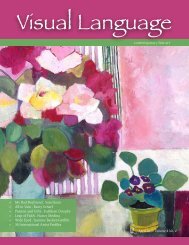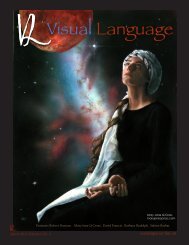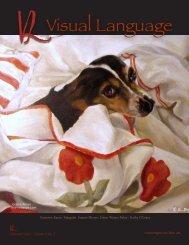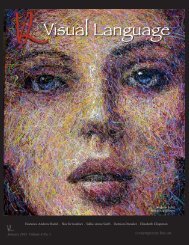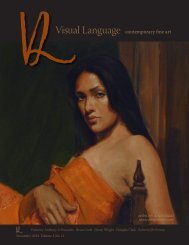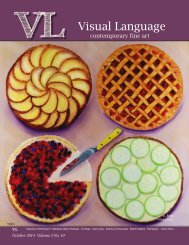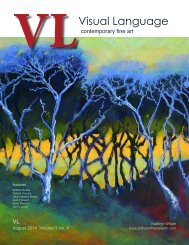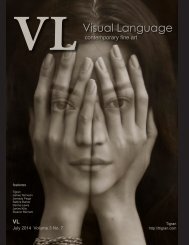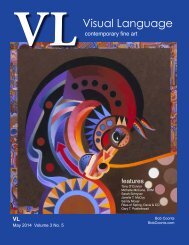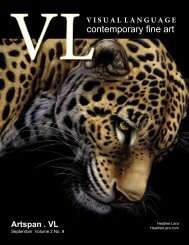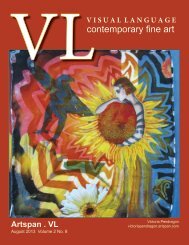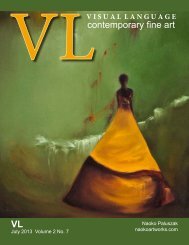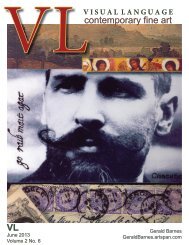Visual Language Magazine Contemporary Fine Art Vol 3 no 9
Vol 3 No 9 Visual Language Magazine Contemporary Fine Art featuring Wildlife, Equine Art and more. Cover Artists is Texas Artist James Loveless. Featured are the VL top artists to collect Isabelle Gautier, Lelija Roy, Linda McCoy, Bob Coonts, and Alejandro Castanon; CFAI Colors on My Palette, Patricia A. Griffin; Visual Language studio visit with Marcia Baldwin, James Loveless, Milton Wagoner and J. W. Burke; Barry W. Scharf shares American Artist Today; Artspan Spotlight with Jan Sasser; CFAI.co Art Showdown; VL Photographer Fran J Scott. Visual Language Magazine published through Graphics One Design. Visual Language is the common connection around the world for art expressed through every media and process. The artists connect through their creativity to the viewers by both their process as well as their final piece. No interpreters are necessary because Visual Language Magazine crosses all boundaries.
Vol 3 No 9 Visual Language Magazine Contemporary Fine Art featuring Wildlife, Equine Art and more. Cover Artists is Texas Artist James Loveless. Featured are the VL top artists to collect Isabelle Gautier, Lelija Roy, Linda McCoy, Bob Coonts, and Alejandro Castanon; CFAI Colors on My Palette, Patricia A. Griffin; Visual Language studio visit with Marcia Baldwin, James Loveless, Milton Wagoner and J. W. Burke; Barry W. Scharf shares American Artist Today; Artspan Spotlight with Jan Sasser; CFAI.co Art Showdown; VL Photographer Fran J Scott. Visual Language Magazine published through Graphics One Design. Visual Language is the common connection around the world for art expressed through every media and process. The artists connect through their creativity to the viewers by both their process as well as their final piece. No interpreters are necessary because Visual Language Magazine crosses all boundaries.
Create successful ePaper yourself
Turn your PDF publications into a flip-book with our unique Google optimized e-Paper software.
VL<br />
Studio Visit JW Burke<br />
The Lonesome Crowded West by Dave Justus<br />
Some artists say they feel compelled to create, as if a<br />
voice inside is driving them in their craft. But for J.W.<br />
Burke, art was all about getting the voices to stop.<br />
In 1988, Burke was eighteen years old, living in<br />
Carmel, California and working maintenance for a<br />
wealthy businessman. “I spent my days off roaming<br />
the streets,” he recalls, “partly chasing girls, and partly<br />
admiring the many incredible galleries.” But his wideopen<br />
future would come crashing down at the hands<br />
of a group of his peers.<br />
“As a cruel prank, they poisoned me with a massive<br />
LSD overdose,” he says. The drugging caused him to<br />
suffer severe constant delusions, including both audio<br />
and visual hallucinations, and to harbor para<strong>no</strong>id<br />
thoughts. “These mimicked the symptoms of para<strong>no</strong>id<br />
schizophrenia. I was unable to maintain my sanity.”<br />
For years, Burke lived either on the streets, where<br />
he got in trouble with the law, or in mental health<br />
hospitals, where he struggled to regain his faculties.<br />
“I lived filthy and homeless,” he says, “begging for<br />
change and sleeping in a box. My delusions over the<br />
years had convinced me that I was somehow being<br />
controlled by, or tortured by, manmade voices.” The<br />
sounds emanating from public television or radio were<br />
a source of agonizing torment for him.<br />
“In September of 1997,” he recalls, “my delusions<br />
drove me to commit two acts of robbery, both without<br />
bloodshed. I remember clearly how, upon my arrest,<br />
as soon as I was handcuffed and placed in the police<br />
car, my delusions stopped—dead quiet. No voices, <strong>no</strong><br />
hallucinations, <strong>no</strong> disorientation… just the sound of<br />
the car and the static of the police radio.”<br />
But the sudden silencing of a decade’s worth of <strong>no</strong>ise<br />
didn’t mean everything was fixed, or that Burke was<br />
whole and healthy again. “The task of rebuilding my<br />
sanity lay before me while I awoke to the fact that I<br />
faced spending the remainder of my life in prison,” he<br />
says. Fortunately, he had a tool for that rebuilding.<br />
“When I was eleven,” Burke remembers, “my mother<br />
bought me a sketchpad and charcoal pencils, saying,<br />
‘Here, I think you are going to be an artist.’” He<br />
had balked, and had grown up believing that art was<br />
beyond his capabilities. But in prison, with time and<br />
determination on his side, he took up his materials<br />
and started to create.<br />
“I began drawing in my cell to help stabilize, exercise,<br />
and restructure my mind against relapse,” he says.<br />
“Soon I asked myself, ‘What can you do to save yourself<br />
What are your options’” Feeling that the prison<br />
system gave him few ways to succeed, he faced<br />
down his lengthy term and made his decision. “To<br />
become an artist or a writer would allow me two ways<br />
to strengthen my mind. One, to teach myself a career<br />
that could lead to financial independence, and two, to<br />
obtain possible assistance in regaining my freedom.”<br />
Frustrated by the lengthy waiting list and selection<br />
process for the prison’s “Craft Shop,” where inmates<br />
have the opportunity to earn an income for their families<br />
or themselves when they get out, Burke has found<br />
what solace he can in his situation. “In my drawing<br />
lessons over the years,” he says, “I slowly found that<br />
any moment I wasn’t drawing was time wasted. My<br />
work improved, and I learned that once I understood<br />
how to achieve accuracy in drawing, I could create<br />
anything, which meant all sorts of excitement and<br />
pride of achievement.”<br />
Now, Burke estimates, “I work at drawing ten to fourteen<br />
hours a day, seven days per week. While I create<br />
artwork on a variety of subject matter, I especially<br />
enjoy creating extremely detailed Westerns depicting<br />
ranch scenes, rodeo, or Old West themes.”<br />
Perhaps <strong>no</strong>t surprisingly for a man confined, Burke<br />
speaks eloquently on the evocative, escapist qualities<br />
of art. “I usually work in graphite or colored pencil,” he<br />
<strong>no</strong>tes. “The black and white of graphite has the ability<br />
to transcend time, as well as create realistic textures<br />
that work well together with the detail to make you almost<br />
smell the leather, feel the heat of the day, or hear<br />
the pounding of hooves.”<br />
Right Page: Bandit<br />
http://www.artbyjwburke.com/<br />
90 | VL <strong>Magazine</strong> - <strong>Visual</strong><strong>Language</strong><strong>Magazine</strong>.com



